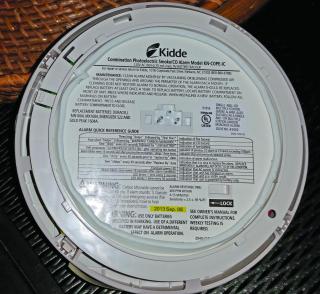A Message from the Fire Chief: Carbon Monoxide Detectors

It is that time of year again, heating season. While the temperature drops and we use more and more fuel to keep our homes warm, it is critical to think about carbon monoxide and ensuring you are protected from this colorless, odorless gas.
According to the CDC, at least 430 people die from carbon monoxide poisoning each year in the U.S. Approximately 50,000 people in the U.S. visit emergency rooms due to accidental CO poisoning. When inhaled, carbon monoxide is picked up and transported by your red blood cells, replacing oxygen in the process. According to the CDC, the symptoms of CO poisoning include headache, dizziness, weakness, upset stomach, vomiting, chest pain, and confusion. If you think that there is a chance of this condition, call 9-1-1 and your local fire department will respond to check out your residence.
Last year, the National Fire Protection Agency (NFPA) included the requirements for carbon monoxide detectors within the NFPA-72 standard for Fire Alarm and Signaling Code. Similar to smoke detectors, it is recommended to have a carbon monoxide detector inside or immediately outside of all sleeping areas, and on each floor of the home, including the basement. For any home which has some form of combustion for heating (burning fuels such as wood, pellets, oil, kerosene, propane, natural gas, etc.), a carbon monoxide detector will be your first and only warning of the possible deadly build-up of this gas. Even if your home does not have any of these heating methods, but you have a generator which will run when the power is out, a detector is critical to your safety. Attached garages also pose a threat to increased levels of CO in the home.
The NFPA recommends all smoke detectors be replaced every 10 years. This is good practice, but is even more important with carbon monoxide detectors. The sensors which detect CO have a limited life, and most detectors will start an internal count-down once energized for the first time. This is usually within five to seven years. After this time has expired, detectors will begin to chirp or alert you that they have surpassed their useful life.
Fire departments in Lincoln County routinely respond to carbon monoxide investigations or carbon monoxide detectors either alarming or sounding. For all detectors, there are usually different indications for when an alarm exists or when there is something with the detector which requires attention. For alarm conditions, the detectors will emit a constant noise and/or message. For combination detectors, there may be a voice message which announces which hazard exists, either smoke or carbon monoxide. For non-emergency conditions, detectors will often “chirp” which is a very short noise every 30 seconds or longer. This usually means that the battery needs to be replaced, the detector cleaned, or there is some type of malfunction. Most often, the various alarm conditions are explained on back of the detectors.
In Damariscotta, we have responded to numerous calls that have to do with carbon monoxide detectors. Some of the times, we respond to those annoying chirps which indicate either an end of sensor life or battery condition. We have also had many close calls, where dangerous conditions existed, and were only caught because of working CO detectors. Some of the recent examples of carbon monoxide build-up in the house include: standby generator running and exhaust entering through basement bulkhead, hot coals in a fireplace with the damper closed, vehicle exhaust with an open outside garage door, poor draft from chimney, and a furnace malfunction.
The dangers of carbon monoxide poisoning are real and happen in this area, especially this time of year. Please protect yourself and family by ensuring you have an adequate number of detectors installed and are in working order. If you are in doubt on whether you have an emergency which relates to carbon monoxide, please ask for help. Early detection and response have a much greater chance or a successful outcome.
Be safe out there.
John Roberts,
Fire Chief, Damariscotta
Massasoit Engine Co

